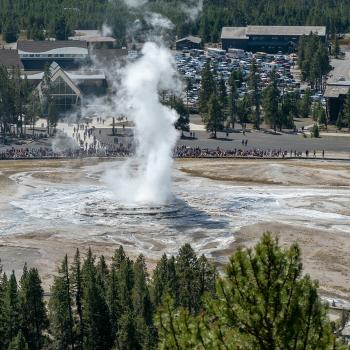
A trio of new articles went up today in Interpreter: A Journal of Latter-day Saint Faith and Scholarship. We hope that you’ll both enjoy them and find them helpful. They are:
“Witnessing to the New Witness,” written by Brant A. Gardner
Review of Robert A. Rees, A New Witness to the World (Salt Lake City: By Common Consent Press, 2020). 244 pages. $9.95 (paperback).
Abstract: Robert A. Rees has written about the Book of Mormon for over sixty years. In this book are collected sixteen essays that all focus on different aspects of the text of the Book of Mormon, and two that provide a personalized interaction. The topics range from the examination of the spiritual biographies of Nephi and Ammon to the issue of automatic writing as a possibility for the dictation of the Book of Mormon to an essay examining the Nephite 200-year peace.
“The Body As the Temple of God,” written by LaReina Hingson
Abstract: Metaphors occur when there is a contradiction in the senses of the words used that cause the text to be interpreted non-literally, as Paul Ricoeur has noted. The Apostle Paul’s letter to the Corinthians describing the body as a temple has been taken to be one such scriptural metaphor: “Know ye not that ye are the temple of God, and that the Spirit of God dwelleth in you? … know ye not that your body is the temple of the Holy Ghost which is in you?” (1 Corinthians 3:16; 6:19). As a metaphor, it is a strong one. The supposed contradiction between a temple and a body includes the inanimate nature of the temple, its holiness in contrast to the natural man, and its unchanging, eternal purpose. The non-literal interpretation of both the body and the temple being a place where the spirit of God can dwell is emphasized in the metaphorical reading and rightly allows us to consider how we may invite the spirit into our lives. Yet to reduce the “body as temple” doctrine to a mere metaphor robs us of the deeper understanding of the body and its role in our spiritual progression and exaltation in the Plan of Happiness. Using the common characteristics archeologists and temple scholars use to classify various sites as temples across the world, this paper shows how the human body can rightly and without contradiction be called a temple of God (D&C 93:35).
“Interpreting Interpreter: Bodies as Literal Temples,” written by Kyler Rasmussen
This post is a summary of the article “The Body As the Temple of God” by LaReina Hingson in Volume 52 of Interpreter: A Journal of Latter-day Saint Faith and Scholarship.
An introduction to the Interpreting Interpreter series is available at https://interpreterfoundation.org/interpreting-interpreter-on-abstracting-thought/.
The Takeaway: Hingson argues that the connection between temples and physical bodies is more than just metaphor, with bodies able to be literally classified as temples according to various scholarly criteria.
***
My wife and I attended the funeral today for our friend, neighbor, and fellow ward member, Phil LeFleur. He was a very good man, as I knew from direct personal experience and as several of those speaking and praying at the service today explicitly said. By contrast, I’m not a particularly good man. I realize, of course, that funeral eulogies (as befits the word eulogy itself, from Greek eulogia [“praise,” “good or fine language,” “speaking well (of)”) focus on the positive things that can be said about a person who has died, and tend to omit anything negative. But he was a good man, and there isn’t very much negative to be said. And that’s been true of the past several funerals that I’ve attended. I’ve found them inspiring. They remind me of areas in which I acutely need very serious improvements. Here’s something, though, that I’ve long found, well, striking: My small group of obsessive detractors are certain, of course, that I’m a very bad person. It’s not so much that they’ve exaggerated my villainy, though they have. It’s that, while they’ve almost entirely missed my actual flaws, they’ve attributed a whole host of desperately evil qualities to me that are overwhelmingly fictional. Weird.
***
And, speaking of weird, do you worry about illegal immigration and porous borders? Do you hold political views that you shouldn’t hold? Do you believe in God? For centuries, people have had to suffer under such ghastly burdens. But there’s good news! A medical cure may be on the horizon!
“Scientists claim zapping brains with magnets can treat belief in God”
This article, written several years ago by the statistician William Briggs and kindly brought to my attention at the time by Charles Steinman, points out a few of the problems in the study under consideration.
But I have some additional reservations. How, for example, are we to distinguish the shutting down of “certain groups of neurones” from (hopefully temporary) brain damage? And does anybody else out there feel at least a tiny bit uncomfortable with an attempt to change human opinions by means of magnets (or any other sort of technology)? What if we can find a scientific cure for voting Democratic? What if atheism can be medically treated? Can we use aversion therapy to decrease the sales of books by Richard Dawkins? Would my blog attract more readers if I could aim a giant ray gun at Los Angeles? If so, should I do it?
This was a bizarre item. And I’ll be really surprised, along with Dr. Briggs, if it holds up.
***
Finally, here are some terrifying specimens from the Christopher Hitchens Memorial “How Religion Poisons Everything” File© that I’ve somehow failed to share with you:
“Latter-day Saints in Malawi on Africa’s east coast rebuild bridge after Tropical Storm Ana”
“Recent Church wheelchair donation commemorates 16 years of partnership in Argentina”
And this one is especially striking:












